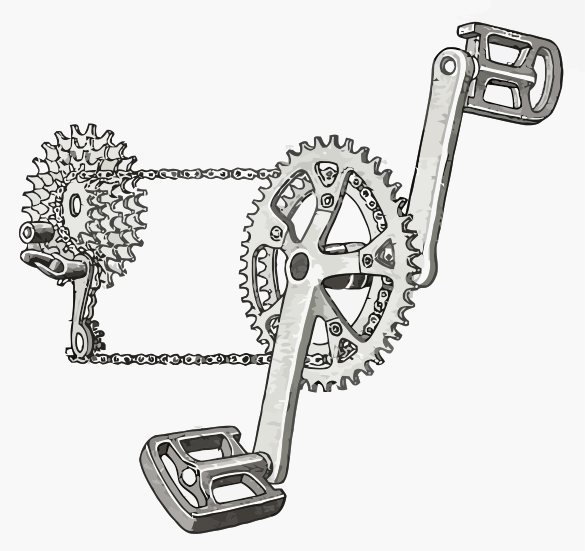Bicycle Gears: Often Poorly Understood Making For a Tougher Ride
Table of Contents

Bicycle gears are designed to allow the rider to choose from different levels of pedaling difficulty, therefore enabling a slow moving hill climb while maintaining a high pedaling cadence. Likewise, the gears allow for higher speeds during a descent. Simply put, by adjusting the gears you are altering the distance you travel compared to the revolutions your feet make.
On a typical road bike there are gears at the front and at the back. On the front gear you'll find either 2 or 3 rings (we'll discuss the difference in a bit). With the front gearing system you will find it easier to pedal when the chain is sitting on the smaller ring and harder to pedal when the chain is on the larger ring. Therefore, when you want to climb a hill you should put the chain on the smaller ring and when you're going downhill or are on a flat surface, you should put the chain on the larger ring in order to maintain or increase speed.
Front Gears
The front gearing system is controlled by the front derailleur which is used to shift the chain up or down depending on the position of the gear lever on the handlebars. If the front derailleur is not adjusted properly you will not be able to change gears; the chain will fall off when you change gears; or the chain will rub and make noise on the derailleur cage. The numbering system of the front rings is that the largest one is referred to as #1, then #2, and then #3 if there is a third ring.
Rear Gears
On the rear gearing system there are typically between 7 and 11 chainrings, depending on the system you purchase. These work in an opposite manner to the front gears. At the back, the smaller chainring makes it harder to pedal and the largest chainring makes it easier to pedal. So, as an example, going uphill you will put your chain on the larger chainring. Typically, the smallest chain ring has 11 or 12 teeth, and the largest chainring has about 28. However, if you do a lot of hill climbing you can look for a cassette (that's the device that holds the chain rings) with more teeth e.g. 32 teeth. The rear gears are controlled by the rear derailleur which moves the chain up or down based on what you do with the gear lever on the handlebars. The rings on the rear cassette also have numbers with the largest ring is referred to as #1, the next smaller one is #2, and so on.
Getting the Most Out Of Your Gears
Changing gears with the front derailleur will give you a bigger gear change than changing the back gears. So, if you want a big change you would use the front system and if you want a smaller change you would use the rear system. A real world example is dropping the front gear as you approach a hill and then as you slow down on the hill move the back gears up.
Higher gear vs Lower gear: this can sometimes be confusing. When you hear the term higher gear it means it is harder to pedal.
Down shifting means going to a lower/easier gear. Upshifting means going to a higher/harder gear.
If you are new to this kind of bike just get on and start riding and playing with the gears. You'll soon get the feeling of how they work, and you won't have to worry about numbers. Here's some basic advice:
- Always be pedaling when you are changing gears, otherwise you will strip the cable and your gears won't work anymore.
- Change gears slowly so you don't jam the chain, especially for the front derailleur.
- Try to have the chain lined up as much as possible. So, avoid having the chain on the largest ring at the back and the largest ring at the front, or the smallest ring at the back and the smallest ring at the front. This will bend the chain over time and it will need replacing.
- Most of all, don't forget to change your gears. A lot of riders pick a combination and stick to it regardless of whether they're going uphill or downhill. They're working harder than they need to!
Different Bikes, Different Gears
On mountain bikes the gears will be ‘easier'. That is, the back rings will be larger and the front rings will be smaller. This is because on a mountain bike you typically need easier gears for riding off road and possible going uphill on dirt paths. There are also some bikes with gears only in the back, which are typically used for casual riding or for commuting. Finally, there are also single gear bikes, which only have one gear which are ideal for flat, casual riding these are perfect.
How many gears do you need? This is a trick question. In fact, it doesn't tell you much at all. The correct question should be, what gear range do you need? Meaning, how easy do you want to be able to gear to and how hard do you want to be able to gear to. This will determine how easily you can climb a hill or how steep a hill you can handle. Similarly, the gears will limit how fast you can pedal when you are going downhill or when you have a tailwind. Two bikes with the same number of gears can have a different range. Last year when I was riding in the Canadian Rockies with my road bike, I changed the rear cassette so the largest ring was a 36 instead of a 28. The number of gears was still the same (10) but the range was much greater.



Leave a Reply